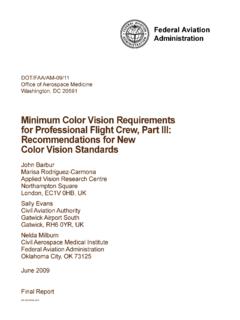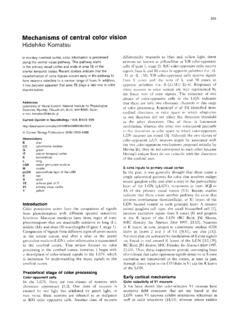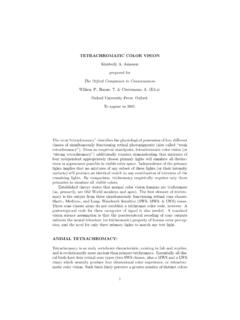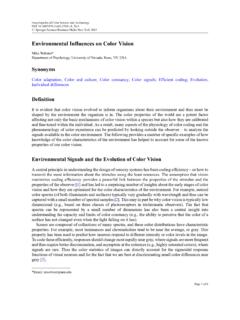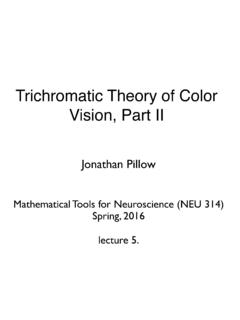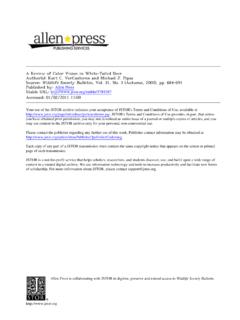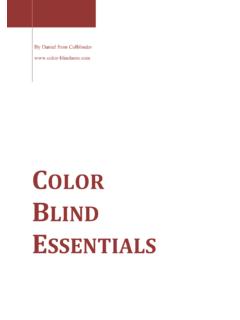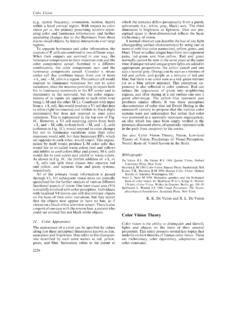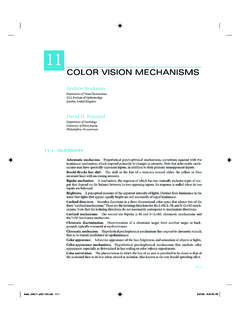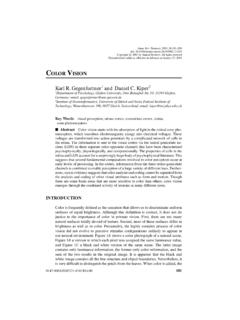Transcription of 1254 Ishihara Instructions - Stanford University
1 Ishihara InstructionsThe Series of PlatesDesigned as aTest for color DeficiencySHINOBU Ishihara , Emeritus of the University of TokyoMember of the Japan AcademyConcise EditionKANEHARA & CO., JAPANI ntroductionThis series of plates is designed to provide a test which gives a quick and accurate assessment of colorvision deficiency of congenital origin. This is the commonest form of color vision cases of congenital color vision deficiency are characterized by a red-green deficiency which maybe of two types; first, a protan type which may be complete (protanopia) or partial (protanomalia), and,secondly, a deutan type which may be complete (deuteranopia) or partial (duteranomalia).In protanopia the visible range of the spectrum is shorter at the end compared with that of the normal, andthat part of the spectrum which appears to the normal as blue-green, appears to those with protanopia asgrey.
2 The whole visible range of the spectrum in protanopia consists of two areas which are separatedfrom each other by this grey part. Each area appears to those with protanopia as one system of color withdifferent brightness and saturation within each area, the color in one area being different from that of theother. The red with a slight tinge of purple which is the complementary color of blue-green appears alsoas deuteranopia, that part of the spectrum which appears to the normal as green, appears as grey, andthe visible range of the spectrum is divided by this zone into two areas, each of which appears to be ofone system of color . The visible range of the spectrum is not contracted, in contrast to protanopia.
3 Purple-red which is the complementary color of green appears also as protanomalia and deuteranomalia, there is not part of the spectrum which appears grey. But the part ofspectrum which appears to those with protanopia as grey, appears to those with protanomalia as agrayish indistinct color , and likewise, the grey part of the spectrum seen by the person with deuteranopiaappears to those with deuteranomalia as a indistinct color close to , one of the peculiarities of red-green deficiencies is that blue and yellow colors appear tobe remarkably clear compared with red and green colors. The application of this peculiarity to the test forcolor vision deficiencies is the distinguishing feature of this the congenital color vision deficiencies, although very rare, there is total color weakness.
4 The colorsensitivity of the total color weakness to red and green, as well as to yellow and blue is very low and onlythe clear colors can be perceived; but, except for the color sensitivity, there is no abnormality in the visualfunctions. The plates in this book form an easy method of establishing the diagnosis on such cases and indistinguishing them from cases of red-green is also a very rare group of persons who suffer from total color blindness and show a completefailure to discriminate any color variations, usually with an associated impairment of central vision withphotophobia and , a failure in the appreciation of blue and yellow may be termed tyritanomalia if partial, andtritanopia if complete, but, even if such cases do exist, they are extremely rare.
5 The plates in this bookare not designed for the diagnosis of such to use the testThe plates are designed to be appreciated correctly in a room which is lit adequately by daylight. Theintroduction of direct sunlight or the use of electric light may produce some discrepancy in the resultsbecause of an alteration in the appearance of shades of color . When it is convenient only to use electriclight, it should be adjusted as far as possible to resemble the effect of natural daylight. The plates areheld 75 cm. from the subject and tilted so that the plane of the paper is at right angles to the line of numerals which are seen on plates are stated, and each answer should be given without more thanthree seconds is not necessary in all cases to use the whole series of plates.
6 Plates 12, 13 and 14 may be omitted ifthe test is designed merely to separate the color defectives from those with normal color of the platesNo. 1. Any subject, whether with normal or defective color vision will read correctlythe figures 12 . This plate is used mainly for preliminary explanation of thetest process to the 2. Normal subjects will read 8 and those with red-green deficiencies 3 .No. 3. Normal subjects will read 5 and those with red-green deficiencies 2 .No. 4. Normal subjects will read 29 and those with red-green deficiencies 70 .No. 5. Normal subjects will read 74 and those with red-green deficiencies 21 . Correctly decipherable by normal subjects, but illegible or hard to read for thosewith red-green 8.
7 Clearly 2 for normal subjects but obscure for those with 9. Normal subjects can hardly read it, but most of those with red-green deficienciessee the figure 2 in 10. Normal subjects can usually read the figures 16 , but most of those with red-green deficiencies 11. In tracing the winding line between the two x s, the normal trace the bluish-green line, but the majority of those with color vision deficiencies are unable tofollow the line or follow a line different from the normal 12. Normal subjects and those with mild red-green deficiencies see the figures 35 but protanopia and strong protanomalia will read 5 only, and deuteranopia andstrong deuteranomalia 3 13. Normal subjects and those with mild red-green deficiencies see the figures 96 but protanopia and strong protanomalia will read 6 only, and deuteranopia andstrong deuteranomalia 9 14.
8 In tracing the winding lines between the two x s, the normal trace along thepurple and red protanopia and strong protanomalia only the purple line is traced, and incase of mild protanomalia both lines are traced but the purple line is easier deuteranopia and strong deuteranomalia only the red line is traced andin case of mild deuteranmalia both lines are traced but the red line is easier of the resultsAs assessment of the readings of plates 1 to 11 determines the normality or defectiveness of color 10 or more plates are read normally, the color vision is regarded as normal. If only 7 or less than 7plates are read normal, the color vision is regarded as deficient. However, in reference to plate 9, onlythose who read the numerals 2 and read it easier than those on plate 8 are recorded as is rare to find a person whose recording of normal answers is 9 or 8 plates.
9 An assessment of such acase requires the use of other color vision tests, including the of the plateIt is important that the book of test plates should be kept closed, except during use, because undueexposure to sunlight causes a fading of the color of the to each plateNumberOf PlatesNormalPersonPerson with Red-Green Deficiencies Person with Total ColorBlindness and Weakness1121212283X352X42970X57421X67XX7 45XX82XX9X2X1016XX11 TraceableXXProtan DeutanStrong Mild Strong Mild12355(3) 533 (5)13966(9) 699 (6)14 Can trace twolinesPurplePurple(red)RedRed(purple)x The mark X shows that the plate cannot be read. The numerals and winding lines in parenthesis showthat they can be read or traced but they are comparatively unclear.










